
Moray eels, or Muraenidae, are a family of eels whose members are found worldwide. There are approximately 200 species in 15 genera which are almost exclusively marine, but several species are regularly seen in brackish water, and a few are found in fresh water.

The ribbon eel, also known as the leaf-nosed moray eel or bernis eel, is a species of moray eel, the only member of the genus Rhinomuraena. The ribbon eel is found in sand burrows and reefs in the Indo-Pacific Ocean. Although generally placed in the moray eel family Muraenidae, it has several distinctive features leading some to place it in its own family, Rhinomuraenidae.

The superorder Elopomorpha contains a variety of types of fishes that range from typical silvery-colored species, such as the tarpons and ladyfishes of the Elopiformes and the bonefishes of the Albuliformes, to the long and slender, smooth-bodied eels of the Anguilliformes. The one characteristic uniting this group of fishes is they all have leptocephalus larvae, which are unique to the Elopomorpha. No other fishes have this type of larvae.

Gymnothorax is a genus of fish in the family Muraenidae found in Atlantic, Indian, and Pacific Oceans. With more than 120 species, it the most speciose genus of moray eels.
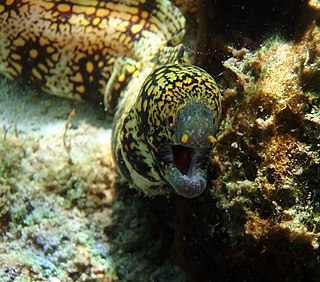
Echidna is a genus of moray eels in the family Muraenidae.
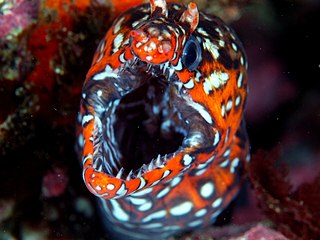
Enchelycore is a genus of moray eels in the family Muraenidae. Enchelycore species are generally small to medium-sized eels, most ranging from 2 to 3 feet in length, with the largest being the Mosaic Moray, which reaches a length of 6 feet (180 cm). Members of the genus feature distinctive, curved jaws that prevent them from fully closing their mouth and aids them in catching, and holding on to prey. Enchelycore species can also feature extremely bright colors and ornate markings.
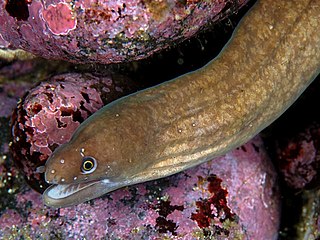
Anarchias is a genus of moray eels in the family Muraenidae.

The Kidako moray is a species of marine fish in the family Muraenidae. It inhabits coral reefs or lagoons and could be found in tropical and subtropical seas near Taiwan, Japan, and Australia. The species is diurnal, which means it is more active in the daytime than the nighttime. It is also piscivorous: it consumes fish, octopus, and squid. Other than the Kidako moray, there are about 200 species of moray eels in the Muraenidae family. The Kidako moray doesn't attack humans unless they are provoked. However, due to the menacing looks of the Kidako moray and moray eels in general, they are feared by divers and snorkelers.
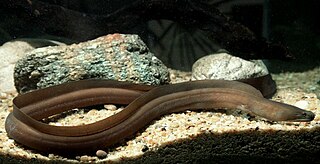
The slender giant moray or Gangetic moray, Strophidon sathete, is the longest member of the family of moray eels. It is in the genus Strophidon. The longest recorded specimen was caught in 1927, on the Maroochy River in Queensland; it measured 3.94 metres (12.9 ft) This species is characterized by an elongated body, as well as brownish-grey dorsal coloration which pales towards the venter.
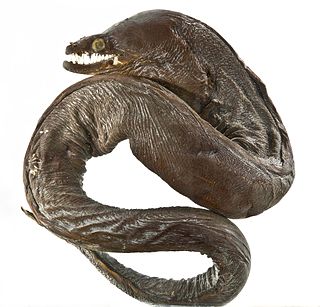
The viper moray is a species of saltwater eel, the only member of the genus Enchelynassa of the family Muraenidae. It is found in the Indo-Pacific oceans. It can grow up to 250 cm.

The California moray is a moray eel of the family Muraenidae, found in the eastern Pacific from just north of Santa Barbara to Santa Maria Bay in Baja California. They are the only species of moray eel found off California, and one of the few examples of a subtropical moray. They typically occupy boulder or cobble habitats up to 40 m in depth. They can attain lengths of about 5 ft (1.52 m) and are believed to live for upwards of 22–26 years. Like other morays, they have no pelvic or pectoral fins or gill covers.
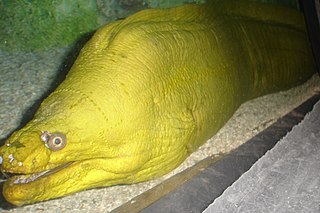
The green moray is a moray eel of the family Muraenidae, found in the western Atlantic Ocean from Long Island, New York, Bermuda, and the northern Gulf of Mexico to Brazil, at depths down to 40 metres (130 ft). Its length is up to 2.5 metres (8.2 ft). It is the largest moray species of the tropical Atlantic and one of the largest species of moray eel known. Though it is not considered endangered, the species is particularly under-studied and estimated to be undercounted by up to 400% in single-pass visual surveys.
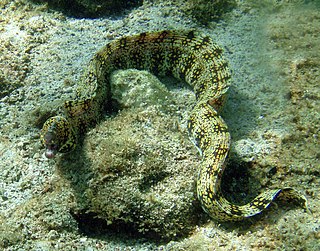
The snowflake moray, also known as the clouded moray among many vernacular names, is a species of marine eel of the family Muraenidae. It has blunt teeth ideal for its diet of crustaceans, a trait it shares with the zebra moray.

The giant moray is a species of moray eel and a species of marine fish in the family Muraenidae. In terms of body mass, it is the largest moray eel; however, the slender giant moray is the largest in terms of body length.

The Asian swamp eel, also known as rice eel, ricefield eel, rice paddy eel or white rice-field eel, is a commercially important air-breathing species of fish in the family Synbranchidae. It occurs in East and Southeast Asia, where it is commonly sold and eaten throughout the region. It has been introduced to two areas near the Everglades in Florida and near Atlanta in Georgia.

Cavefish or cave fish is a generic term for fresh and brackish water fish adapted to life in caves and other underground habitats. Related terms are subterranean fish, troglomorphic fish, troglobitic fish, stygobitic fish, phreatic fish, and hypogean fish.

Eels are ray-finned fish belonging to the order Anguilliformes, which consists of eight suborders, 20 families, 164 genera, and about 1000 species. Eels undergo considerable development from the early larval stage to the eventual adult stage and are usually predators.

Echidna nocturna is a moray eel found in the eastern Pacific Ocean, in the Gulf of California and around Peru and the Galapagos Islands. It was first named by Cope in 1872, and is commonly known as the freckled moray or the palenose moray. It was discovered that Echidna nocturna and Muraena acutis are the same species.
The mud-dwelling moray is a species of eel in the family Muraenidae, and the only species in the monotypic genus Diaphenchelys. It was described by John E. McCosker and John Ernest Randall in 2007. It is a marine, tropical eel which is known from Indonesia, in the western Pacific Ocean. It dwells at a depth range of 15 to 32 metres, and inhabits muddy bottoms, from which its species epithet, "pelonates", is derived. Males can reach a maximum total length of 46.5 centimetres (18.3 in).

The electric eels are a genus, Electrophorus, of neotropical freshwater fish from South America in the family Gymnotidae. They are known for their ability to stun their prey by generating electricity, delivering shocks at up to 860 volts. Their electrical capabilities were first studied in 1775, contributing to the invention in 1800 of the electric battery.



















